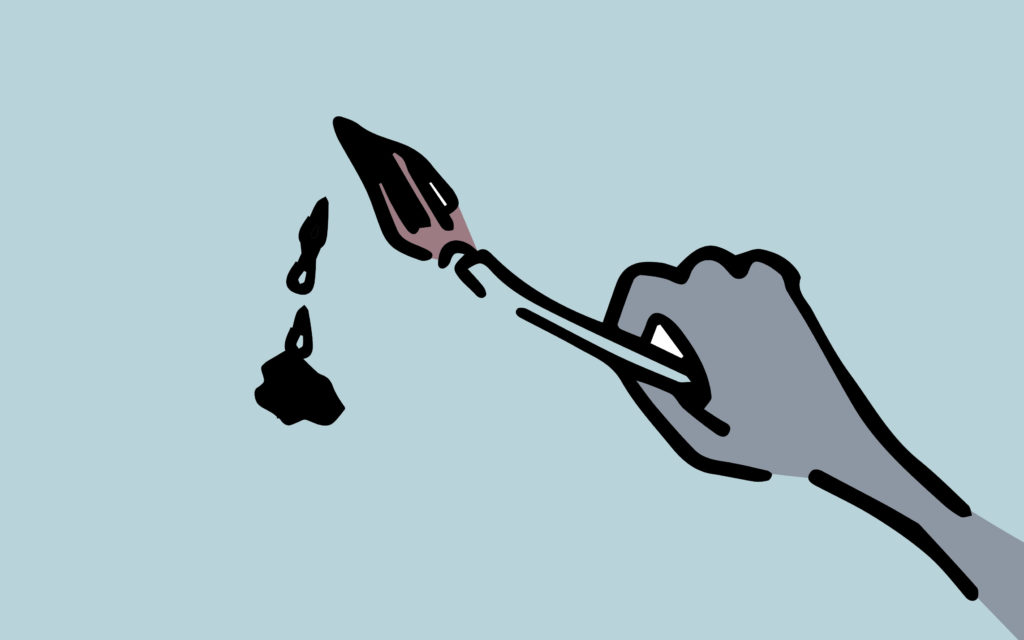Had you lived in Paris a couple of centuries ago, you may have witnessed a young artist — his clothes daubed in smears of browns and grays — regularly leaving the hospital across the street from his studio. This hospital, in fact, is why he chose this particular avenue for his studio. You may have noticed that he often carried cloth bags that seemed to be leaking. If you asked him what they contained — not that he would have cared to waste a second in speaking with you — he might have grunted that they held a human arm, or a human leg, or a human head. This purposefully-striding man was Théodore Géricault, and he had decided to make a name for himself as a new kind of French painter.
Géricault’s eyes were on a particular prize: he wished to exhibit a canvas at the 1819 Paris Salon that would stoke both hate and love. He preferred, naturally, more of the latter; but he knew, as an artist who had lately found himself and exploded into his talents, that polarization was inevitable and beneficial to his cause.
His early teachers had attempted to educate the ambitious painter in the way of English sporting art, extolling the career of someone like Carle Vernet, a French master of depicting horseflesh and dogs. One painted some hounds, adroitly capturing their musculature, as they set off after a fox, proud riders atop their mounts, and you could make what we now call “bank”, in that rich people tended to like these efforts. They were believed to possess class, to show that your station put you above regular workers because leisure was at your disposal.
Géricault, though, was not a painter suited to do a version — even a better version — of what had been done before. He didn’t so much as fall out with his instructors, as leave them behind as — ideologically and, to a degree, geographically, ensconcing himself at the Louvre, where he studied how the masters who had come before him had left tradition and found their own way. He hung out at Versailles, but not for any reasons of pomp — rather, he situated himself within the palace stables, studying just how horses moved and what their muscles did with the slightest of movement. Or, crucially, the occasional absence of any. Nobody has ever painted a muscle that is about to move or has just stopped moving better than Géricault — motion seemed alive even within his understanding of stillness.
The years of 1816 and 1817 were spent in Italy after an affair with an aunt in France had gone awry, as affairs with aunts often do, and in the near-constant company of Michelangelo’s oeuvre with its conjoining of classicism and modern life. Contemporary, timeless. Géricault began to think of other paradoxical schisms of unification — past and present, chastity and promiscuity, dead and living. And he pondered how the human body looks as it rots, having been healthy and thriving a short time ago, and how one might paint a face, a naked torso, to reveal what the human soul resembles as it endures. He needed a field upon which to pitch his battle of schisms and the telltale signs of unity they represented. And so it was in this period that he sought to harness sheer size and raw history, with the painting of a canvas — a very large canvas — depicting what had happened to 147 humans in June 1816 upon what was known by everyone in France as the death raft. He would bring the earth to the sea, and back again.
The subject matter, of course, was infamous in France, the scandal of age in a country that made something of an art of the scandal, an idea that would become literal with Géricault’s effort. The frigate Medusa sailed for a Senegalese port as part of a convoy on a ceremonial mission, what we’d think of as low stakes. France was accepting England’s return of Senegal as part of the Peace of Paris. For this junket, the French navy had appointed Viscount Hugues Duroy de Chaumereys as captain of the Medusa. He had not sailed in two decades. In his zeal to arrive at Senegal first, De Chaumereys sped out of the convoy and traveled alone. His ship went 100 miles off her course and ran aground. Haste frequently makes waste at sea. Attempts to free the ship were unsuccessful, so 250 of the people aboard were ordered into the frigate’s six boats; the remaining 150 were conscripted to a makeshift raft, which would be towed as this ramshackle fleet made for the African coast. The attempt did not last long. After only a few miles, the tow rope was cut. Those on the raft had food for one day, two barrels of water that they immediately lost over the side as everyone fought for them, and six casks of wine, which could not have helped. There would be murder, cannibalism, many suicides, and 15 survivors.
When I think of the worst physical ways to die, I put succumbing to thirst near the top of list. Ever been on something so simple as a long bus ride and forgotten to take a water bottle? The experience can actually be painful, though mundane, and without one being in actual danger. Extend that over days, and now add in the possibility of murder, being consumed by sharks, starvation, and you have what went on with the death raft, to say nothing of perhaps the greatest attendant terror: the thought of, What if no help comes?
Géricault’s 16 x 23-foot painting featured figures both large and larger than life. He was prepped to the gills with his grim studies, and knew, better than any artist ever had, how human flesh de-colored as it decayed. A strange specialty, for certain, akin to what an artist might pursue in an Edgar Allan Poe story, but Géricault would have told you that human nature supplied his sensationalism — he just recorded it, as a poet might try to replicate the song of a bird.
This was Dante’s Inferno at sea, with spume replacing flame, bodies piled atop each other in agonal death orgy. Not exactly an easy sail around the bay. Géricault didn’t just blot up all of the histories he could and baffle medical students who couldn’t understand his fascination with the putrification of the flesh — he had a detective aspect to his studies as well, interviewing two of the fifteen survivors, including a doctor, who certainly owed his life to his profession, as it just made sense to keep the doctor alive rather than pitch him into the sea. The painter’s process was always about immersion, but never more so than with this undertaking, in which it seemed essential that Géricault be able to feel that he, the painter, was also a raft-rider. The testimony had one constant theme — a kind of dignity of hope, that to be without it was to be shorn from part of one’s humanity. There were to be no mad beasts in Géricault’s rendering; the eyes of the still-living on the raft possess an insistent limpidity. The spirit will not go, even as bodies do.
The size of the canvas itself was shocking. It was like hitting the full-screen option on a salacious video which was already a close-up offering, and then voila, right in your face were the folds, trenches, divots, puckerings, hollows, of the human body, writ large at its most vulnerable. We rarely admit this even within our darkest thoughts — and there is truth in the dark, just as there is truth in the light — but one could argue—and Géricault was one such person — that it is the fear of death that stops it from being recognized as erotically-tinged, a kind of final climax to life. The Thanatos orgasm.
There were elements of the traditional history painting in Géricault’s canvas, and certainly of the ancient Grecian and Roman plastic arts, as these figures had the look of statuary come to life, simply to die, but with muscles and definition, not ineffectuality and enervation. They will not break — they will end. A massive distinction. In that gap is encoded the paradoxically human miracle of our potential ability to endure. That visual paradox of statuary having become flesh lent drama to the painting as if humans had mounted a counter-attack on nature: Specifically, against the enfolding, silencing arms of death, the choke-forces that halt years and years of heartbeats in a solitary fraction of a second, as though momentum meant and counted for nothing.
The art world was unaccustomed to what was essentially an earthen seascape. This is the great age of sail, so maritime paintings were French and English staples. Heroism was a frequent subject, as was duty — not, as we have here, the dereliction of duty, and what becomes heroism of endurance, rather than the heroism of cannon and mortar. So far as the intensity of drama went, in the maritime medium, there were antecedents. Géricault had seen a print of the American John Singleton Copley’s Watson and the Shark, in which nine people — the most sacred number of three having been deployed three times — in a dingy struggle to extricate a nude man from a shark — who possesses lips, strangely — that is about to devour him. One of those men is black, which is notable given the census-taking we can do with these kinds of pictorial affairs when it comes to how white they usually are. What’s more, this Black man is clearly overseeing the rescue endeavor. Copley believed in the spirit of man, not the bounds of color. The human possibility is limitless, whereas pigment, as any painter knew, could only go so far. A dingy always feels makeshift, like you are only in it because something didn’t work out as it should elsewhere. If that’s how it goes for a dingy, it goes that much more for a raft, and Géricault also featured a Black man in his painting, one who is either trying to keep his slumped-over, white, fellow-human alive or who has stopped his body — in the last show of shared human dignity — from disappearing forever into the sea. The nod is to Copley, but the more vociferous reference is to that human possibility, free of fetters that come with expectation — not just of color, but classism.
The white man’s arm is draped limply, like the wrist has been pulverized into bone chips, over a wooden crossbar. This crossbar suggests a dismantling of a crucifixion cross, the body having been cut down after the day’s ceremonial killing is done. Géricault knew that he wanted his painting to be a class study, and that angered some people far more than did its gore shock value. These people were all equal. White, Black, young, old. We all are in the human scrum, Géricault seemed to be indicating. Deal with it. And also — look out for each other. There were cads and villains on the raft, no doubt — but they are not his focus.

But the artist wasn’t sure when, if you will, his painting would be set. Would it be just after the raft was cut loose from its tow line? Would it be when all hope was gone and death had been accepted insofar as death can be? To the left of the Black man is a figure who might as well be Plato having come out of his cave for one final reflection in the light of day, before lofting himself, via a seaward leap, into death. Rodin must have had him in mind when he conceived of The Thinker. His fisted hand is not under his chin, but on the side of his head, resting on his cheek, as if frozen in a self-delivered blow, his left-hand rhyming, as Picasso would have put it, with the slack left hand of the caved-in Christ figure.
As the Black man tends to the maintenance of the dead or dying man’s dignity, the raft’s philosopher absently stops another body from rolling into the churn and foam. These people are all in various stages of fight and defeat, but what is clear is that the remaining individuals of the raft are made of formidable stuff. Or — and I love this perspective twist — the murderers have survived, but either retain or are now discovering the ability to comport themselves with decency and consideration. Humans may be simple, they may be complex, or they may be both simultaneously, as I believe, a paradox that no painting has ever captured — or posited — better than this one. In our age, when we snap to judgment, and we think someone is a fine or horrible person based upon how they are smiling or not smiling in a photograph, we should remind ourselves of the work of Géricault — or introduce someone to it.
No less than a young Delacroix worked as Géricault’s assistant, and for the rest of his life, he’d speak about seeing this painting as it was being made. One has the sense that nothing impacted him nearly as much. He even has a cameo, serving as a model for one of the faces that rests flat on the beams of the faltering raft.
But what the philosopher has not yet realized in the painting is that one of the other ships of the convoy has, by some miracle, appeared as a dot on the horizon. This was quite an accident — no one was looking for these people, and here we have Géricault’s genius for implied motion even in stillness — for physical stillness is not the same as mental stillness. Within a compact interval, the philosopher will react; he’ll turn over his left shoulder, because of how he is bent, and see what the other men are shouting about, who are raised in a triangular procession of bodies at the far back right-hand portion of the raft. This gives the painting movement before the movement has happened. A static body thus creates flow, even if it is the illusion of flow, just as seawater is an illusion of drinkable water, and yet water all the same.

Géricault uses that back triangle for a geometrical rhyme with another organizing triangle that features the saddest mast in art history serving as the precipice at left. The mast is in motion, via the wind, the bodies at right are in motion via their attempt to catch the attention of the ship on the horizon, the effect being two rotational pediments that cycle us down onto the raft’s center. We are emotionally, psychologically, in the center of the craft.
Géricault was irked when the painting was first shown because it hung on the wall high over the heads of the viewers. They did not thus become ensnared by the raft, like human splinters been entombed in its wood; they beheld it from a distance that negated its gravitational pull. Later, when it was installed near ground level, the work’s power became such that it could literally make you seasick and other kinds of sick, but also various forms of hopeful. There were so many grays and browns, and no one had ever done a seascape like that. We are creatures of the earth, of terra firma, and in his coloration, and of course Géricault’s figuration, with bodies like hunks of loam, humankind retains its dogged, telltale markings. The sea — the force of nature — washes none of that away, as even in death we see the spirit of endurance as the force of nature itself. Perhaps a force beyond nature.
Géricault took his theme so far that he used a lot of bitumen in his paint, a sheeny pigment which deteriorates to charry black, crimpling the surface, and rendering it incapable of being restored in a painting that is deathless. Another unifying irony and schism. In every regard, the painting exists on its terms, pure freedom of spirit. The un-restorable work is a form of its perishable subjects, the subjects, of course, had become the painting, in part because that subject was both the people of the death raft and not the people of the death raft — let us call it a death raft in a larger, ocean-free sense: The challenge of endurance when hope is removed, and the human necessity to locate hope again. If the hope is not forthcoming in some form or other over the horizon, we search to manifest the vessel within. And so into this painting we go, and so into life. •





